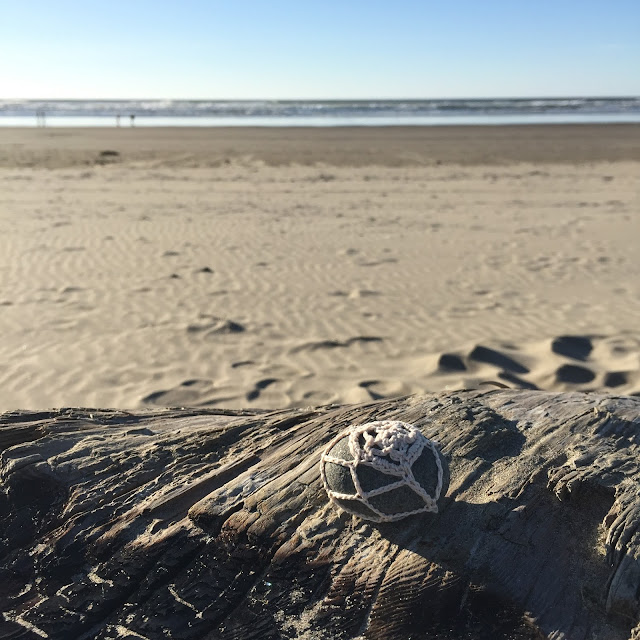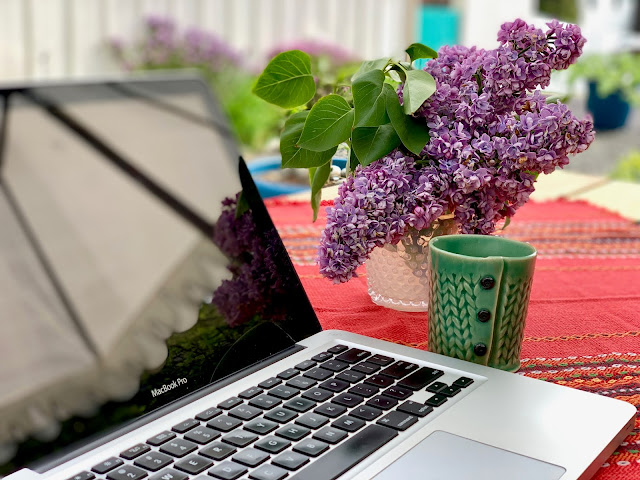DIY Face Mask with Ear Loops, Nose Wire, and Filter Pocket
If you follow me on Instagram or Facebook, you probably know I’ve been making face masks lately. It’s a labor of love, as sewing is not really a thing I gravitate to. I’m surprised though at how much better I’m getting at it, and that I even sort of enjoy having my little makeshift sewing room to hang out in each day. It gives Rick and me a bit of perceived separate space while sharing a 600 square foot house. I wonder how true Tiny House dwellers are managing these days...
A lot of friends are asking me which of the many online patterns I’m using. The truth is, I’ve sort of combined a few favorites into a hybrid pattern that’s easy for me to sew, and is approved by my official mask testers - a friend who works in the local liquor store, and my sister, who does home health care as an occupational therapist. Fit and comfort are top priority. With their guidance, I think I have it sorted out.
These masks are made of woven cotton. They have a pipe cleaner (or other flexible wire) stitched in at the top edge for a custom fit around the nose. They wrap well under the chin. Soft elastic, which at the moment I’m making by cutting up stretchy tights and leggings, makes comfortable ear loops. And while the masks are two layers thick, they also have a pocket hidden within the folds, so an extra filter layer can be added by the wearer.
Please do your own research on appropriate filter material, as well as proper fitting, handling, and washing of homemade face masks. Share this information with friends and family you give these to. And do remind folks that wearing a mask does not eliminate the need for social distancing. Even with masks, our best practice is still to stay home!
I’ve chosen to do this tutorial in photos, as I really didn’t like trying to follow a video when I was learning to make these things. I hope it works to put it together on my iPad, as I’m doing now. Normally I like to create posts on my computer, but ever since I had a new hard drive put in, it’s been practicing social distancing from my iPad and phone, so photos are a big problem.
Please feel free to use this design all you like for masks you intend to give away. I donate them freely to family and friends. I’d prefer you do the same. I do accept donations for supplies, as well as actual supplies from people I know. See if that can work for you too.
DIY Pleated Face Masks with Ear Loops, Nose Wire, and Filter Pocket
Materials:
Tightly woven cotton fabric, washed
Pipe Cleaners or other flexible wire
Stretchy nylon/spandex tights or leggings
Sewing machine and thread
Steam iron
Prep:
Cut fabric into 15” X 8” rectangles.
I rip mine into long, 8” wide strips, and then use a rotary cutter to make 15” lengths.
Cut 12” pipe cleaners in half, and curl the ends in with needles nose pliers, so they aren’t sharp.
Cut the legs of your tights into 1” wide rounds, and give them a good stretch, so the edges curl in. Then cut those open, and into 7” lengths. (If you have 1/4 inch elastic, use it! It’s more elusive than toilet paper these days.)
Iron your fabric. You’ll be doing lots of ironing, but little or no pinning for these.
Next, run some sort of zigzag stitch alone both of the short sides of the rectangle. These will form the pocket later. I like to use stitch “4” in the picture.
Now fold the fabric in half, right sides together, with the stitched edges at the top, and mark 1 1/2” in from each of the top side edges. Stitch only that 1 1/2” on each side across the top, leaving an open gap in between.
Turn the fabric right side out, with the seam centered and facing you. Iron in place, flattening the seam open. There will be a gap for the pocket.
Place one piece of elastic inside the mask, with just a tiny bit peeking out at the top right corner. Stitch this firmly in place, and continue the side seam to just past the center pocket seam. Then pull the other end of the elastic from inside the mask, out the bottom corner, and continue stitching the rest of the side seam, securing the elastic in place. There will be a loop of elastic inside the mask now, and the side seam will pucker a little bit.
Repeat for the other side.
Turn the mask right side out and iron. Be careful NOT to iron the ear loops! They’ll melt!
Now measure for the pleats. Turn the mask so the ear loop edges (side edges) are at the top and bottom, and the pocket opening (inside of mask) is facing you. Measuring along one ear loop edge, mark 1 1/4”, 1”, 3/4”, 1”, 3/4”, 1”. Six little marking in total. Do the same on the other ear loop edge.
Turn the mask so the ear loops are now on the sides. Fold and iron the first pleat by bringing the second marking up to the first.
Now only 4 makings show. Again, bring the second marking up to the first, and iron in place. Repeat one more time for the third pleat. The inside of your mask will look like this.
The front of the mask looks like this.
Stitch the pleats into place, close to the edge, and securing the elastic again as you go. You can pin or clip it if you like, but I’ve found that if I’m careful, I can hold the pleats in place with my hand. One edge is easier for me to do than the other, but it works out.
Top stitch the bottom edge of the mask for stability.
Insert the pipe cleaner into the pocket opening, and line it up at the top edge of the mask. Holding the wire in place, sew a narrow casing around it.
Your mask is finished! Iron it once more, with lots of steam, and celebrate with a cuppa something good. Then make more!
The masks at the top and bottom here are made from a duvet cover we probably won’t need for our Airbnb rental any time soon. The center mask is fabric from the curtains in my bedroom when I was in high school. My dad kept the curtains when he decided to repaint my old room from red (!) to white, and I couldn’t bear to send them to the Goodwill. I wasn’t sure why at the time, but now I’m glad I kept them.
Keep sewing, all you mask makers out there! You’re doing noble work. ❤️






























HI KIM! Great tutorial, but don't is very hard to read on a tablet. Is very light. Love all your fabrics!
ReplyDeleteSilly autocorrect. FONT is very hard to read.
ReplyDelete